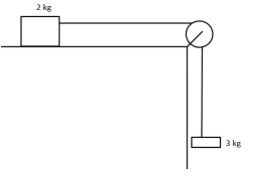
Find acceleration, normal reaction and tension in each case. $\left( {g = 10\,m/{s^2}} \right)$


Answer
469.2k+ views
Hint:This question is pretty simple if you know that tension on both parts of the strings is exactly the same around the pulley, since the strings are considered massless, the question gets even simpler. Also, the surfaces are given to be smooth, hence, there is no friction in the given question. All you need to do is to equate the tension and assume the acceleration of the $2{\kern 1pt} kg$ mass as $a$ which is the acceleration asked in the question.
Complete step by step answer:
We will proceed with the solution exactly as told in the hint section of the solution to the question.
Let us assume a tension ${T_1}$ in the vertical section of the string.
We’ve been given the mass of the lower block as ${M_1} = 3\,kg$
Using this, we can say that:
${T_1} = {M_1}g$
After substituting in the values, we get:
${T_1} = 30\,N$
Now, let’s assume a tension ${T_2}$ in the horizontal section of the string, since tension in the string around the pulley is always equal, we can say:
${T_2} = {T_1} = 30\,N$
Now, let us assume the mass ${M_2} = 2\,kg$ moving with an acceleration of magnitude $a$, now we can say that:
${M_2}a = {T_2}$
We’ve already found out the value of tension in the horizontal section of the string to be the same as the tension in the vertical section of the string. Using this, we can write:
$
\left( 2 \right)a = 30\,N \\
a = 15\,m/{s^2} \\
$
We also need to find the value of normal reaction force on the mass ${M_2}\,\left( { = \,2\,kg} \right)$
We know that normal force is the force perpendicular to the surface. Since there is no vertical movement of the mass ${M_2}$, we can safely say that the normal force in this case is equal to the weight of the box. Hence:
$
N = {M_2}g \\
N = 20\,N \\
$
We’ve found out the values of:
Acceleration, $a = 15\,m/{s^2}$
Normal reaction, $N = 20\,N$
Tension, $T = {T_1} = 30\,N$
Note: Many students commit mistakes by adding the two masses and finding the acceleration by dividing the tension with the combined mass. Although both of the boxes move with the same acceleration, you need to know that only the mass ${M_2}$ is contributing to the value of acceleration.
Complete step by step answer:
We will proceed with the solution exactly as told in the hint section of the solution to the question.
Let us assume a tension ${T_1}$ in the vertical section of the string.
We’ve been given the mass of the lower block as ${M_1} = 3\,kg$
Using this, we can say that:
${T_1} = {M_1}g$
After substituting in the values, we get:
${T_1} = 30\,N$
Now, let’s assume a tension ${T_2}$ in the horizontal section of the string, since tension in the string around the pulley is always equal, we can say:
${T_2} = {T_1} = 30\,N$
Now, let us assume the mass ${M_2} = 2\,kg$ moving with an acceleration of magnitude $a$, now we can say that:
${M_2}a = {T_2}$
We’ve already found out the value of tension in the horizontal section of the string to be the same as the tension in the vertical section of the string. Using this, we can write:
$
\left( 2 \right)a = 30\,N \\
a = 15\,m/{s^2} \\
$
We also need to find the value of normal reaction force on the mass ${M_2}\,\left( { = \,2\,kg} \right)$
We know that normal force is the force perpendicular to the surface. Since there is no vertical movement of the mass ${M_2}$, we can safely say that the normal force in this case is equal to the weight of the box. Hence:
$
N = {M_2}g \\
N = 20\,N \\
$
We’ve found out the values of:
Acceleration, $a = 15\,m/{s^2}$
Normal reaction, $N = 20\,N$
Tension, $T = {T_1} = 30\,N$
Note: Many students commit mistakes by adding the two masses and finding the acceleration by dividing the tension with the combined mass. Although both of the boxes move with the same acceleration, you need to know that only the mass ${M_2}$ is contributing to the value of acceleration.
Recently Updated Pages
Glucose when reduced with HI and red Phosphorus gives class 11 chemistry CBSE

The highest possible oxidation states of Uranium and class 11 chemistry CBSE

Find the value of x if the mode of the following data class 11 maths CBSE

Which of the following can be used in the Friedel Crafts class 11 chemistry CBSE

A sphere of mass 40 kg is attracted by a second sphere class 11 physics CBSE

Statement I Reactivity of aluminium decreases when class 11 chemistry CBSE

Trending doubts
10 examples of friction in our daily life

The correct order of melting point of 14th group elements class 11 chemistry CBSE

Difference Between Prokaryotic Cells and Eukaryotic Cells

One Metric ton is equal to kg A 10000 B 1000 C 100 class 11 physics CBSE

State and prove Bernoullis theorem class 11 physics CBSE

What organs are located on the left side of your body class 11 biology CBSE




